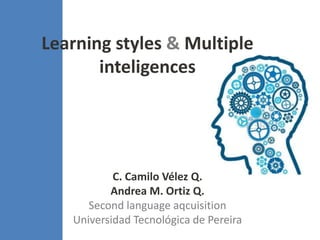Learning styles & multiple inteligences
•Télécharger en tant que PPTX, PDF•
6 j'aime•1,258 vues
SLA Class
Signaler
Partager
Signaler
Partager

Recommandé
Recommandé
Contenu connexe
Tendances
Tendances (20)
Chapter 4 how languages are learned - pasty m. lightbown and nina spada

Chapter 4 how languages are learned - pasty m. lightbown and nina spada
English Learners in 21st-Century Classrooms and Language Acquisition Theories

English Learners in 21st-Century Classrooms and Language Acquisition Theories
En vedette
En vedette (20)
Classification of Exceptionalities(Children with Special Needs)

Classification of Exceptionalities(Children with Special Needs)
Similaire à Learning styles & multiple inteligences
Similaire à Learning styles & multiple inteligences (20)
Teaching children with_learning_disabilities_02 (1)

Teaching children with_learning_disabilities_02 (1)
Dernier
Mehran University Newsletter is a Quarterly Publication from Public Relations OfficeMehran University Newsletter Vol-X, Issue-I, 2024

Mehran University Newsletter Vol-X, Issue-I, 2024Mehran University of Engineering & Technology, Jamshoro
https://app.box.com/s/7hlvjxjalkrik7fb082xx3jk7xd7liz3TỔNG ÔN TẬP THI VÀO LỚP 10 MÔN TIẾNG ANH NĂM HỌC 2023 - 2024 CÓ ĐÁP ÁN (NGỮ Â...

TỔNG ÔN TẬP THI VÀO LỚP 10 MÔN TIẾNG ANH NĂM HỌC 2023 - 2024 CÓ ĐÁP ÁN (NGỮ Â...Nguyen Thanh Tu Collection
Dernier (20)
Asian American Pacific Islander Month DDSD 2024.pptx

Asian American Pacific Islander Month DDSD 2024.pptx
Micro-Scholarship, What it is, How can it help me.pdf

Micro-Scholarship, What it is, How can it help me.pdf
Unit-V; Pricing (Pharma Marketing Management).pptx

Unit-V; Pricing (Pharma Marketing Management).pptx
Basic Civil Engineering first year Notes- Chapter 4 Building.pptx

Basic Civil Engineering first year Notes- Chapter 4 Building.pptx
On National Teacher Day, meet the 2024-25 Kenan Fellows

On National Teacher Day, meet the 2024-25 Kenan Fellows
TỔNG ÔN TẬP THI VÀO LỚP 10 MÔN TIẾNG ANH NĂM HỌC 2023 - 2024 CÓ ĐÁP ÁN (NGỮ Â...

TỔNG ÔN TẬP THI VÀO LỚP 10 MÔN TIẾNG ANH NĂM HỌC 2023 - 2024 CÓ ĐÁP ÁN (NGỮ Â...
ICT Role in 21st Century Education & its Challenges.pptx

ICT Role in 21st Century Education & its Challenges.pptx
Learning styles & multiple inteligences
- 1. Learning styles & Multiple inteligences C. Camilo Vélez Q. Andrea M. Ortiz Q. Second language aqcuisition Universidad Tecnológica de Pereira
- 2. Learning styles theory Neil D. Fleming
- 3. Have you ever wondered… …Why you have difficulty learning from a particular instructor, whereas another seems to explain things in just the right way?
- 4. Have you ever wondered… …Did you ever question why the course that your friend said was so easy turned into a struggle for you?
- 5. Have you ever wondered… …Do you notice that you and your roommate have different opinions on whether or not to have the radio on while you're studying?
- 6. What is “learning styles” To put it simply, learning style is the way you tend to learn best. It involves your preferred method of taking in, organizing, and making sense of information.
- 7. Several benefits of thinking about and trying to understand your learning preferences:
- 8. Several benefits of thinking about and trying to understand your learning preferences:
- 9. Several benefits of thinking about and trying to understand your learning preferences:
- 10. 3 learning style preferences 1. Auditory (learning by hearing) 2.Visual (learning by seeing) 3.kinesthetic (learning by doing)
- 11. Auditory (learning by hearing) • Auditory learners would rather listen to things being explained than read about them. • Reciting information out loud and having music in the background is a common study method. • Other noises may become a distraction.
- 12. Visual (learning by seeing) • Visual learners learn best by looking at graphics, watching a demonstration, or reading. • For them, is easy to look and interpret charts and graphs. • They may have difficulty focusing while listening to an explanation.
- 13. Kinesthetic (learning by doing) • Kinesthetic learners process information best through a “hands-on” experience. • Actually doing an activity can be the easiest way for them to learn. • Sitting still while studying may be difficult, but writing things down makes it easier to understand.
- 14. Multiple inteligence theory
- 15. • Who remembers the class clown in your elementary or high school? • Who remembers the boy who always drew on desks or any paper found? • Or the person who was always the leader in an activity? • Intelligence----- Measured in relationship to reading, writing, or arithmetic skills.
- 16. The Multiple Intelligence Theory Dr. Howard Gardner
- 17. • Hardvard changed his future • * bachelor of arts degree in social relations • Thesis- The retirement community in America • * degree on developmental psychology • thesis- The development of sensitivity to figural and stylistic aspects of paintings
- 18. • 1. Linguistic Intelligence: • Prefer to learn through words and language. • 2. Logical-Mathematical: • Prefers to learn through numbers and logic. • 3. Musical Intelligence: • Prefer the music, sounds and rhytms. • 4. Bodily Kinesthetic Intelligence: • Prefers the physical experience and movement, to touch and feel. • 5. Spatial – Visual Intelligence: • Prefers Pictures, shapes, images, 3D space. • 6. Interpersonal Intelligence: • Prefers to use human contact and learn through communication in teamwork. • 7. Intrapersonal Intelligence- Prefers to use Self Reflection and self discovery on new topics.
- 19. Three suggested possible additions • Naturalist • Spiritual • Moral
- 20. “If a child is not learning the way you are teaching, then you must teach in the way the child learns” Rita Dunna
- 21. Bibliography http://www.sdc.uwo.ca/learning/index.html?styles#auditory http://www.learningrx.com/types-of-learning-styles-faq.htm http://www.ldpride.net/learningstyles.MI.htm#Learning%20Styl es%20Explained https://www.google.com.co/imghp?hl=es&tab=wi http://en.wikipedia.org/wiki/Neil_D._Fleming
